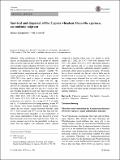Files in this item
Survival and dispersal of the Cyprus Wheatear Oenanthe cypriaca, an endemic migrant
Item metadata
| dc.contributor.author | Xenophontos, Marina | |
| dc.contributor.author | Cresswell, Will | |
| dc.date.accessioned | 2016-02-11T15:40:07Z | |
| dc.date.available | 2016-02-11T15:40:07Z | |
| dc.date.issued | 2016-07 | |
| dc.identifier | 234875443 | |
| dc.identifier | 43931336-90b5-4ba3-97fe-2e05b2937f31 | |
| dc.identifier | 84976307785 | |
| dc.identifier | 000382943900006 | |
| dc.identifier.citation | Xenophontos , M & Cresswell , W 2016 , ' Survival and dispersal of the Cyprus Wheatear Oenanthe cypriaca , an endemic migrant ' , Journal of Ornithology , vol. 157 , no. 3 , pp. 707-719 . https://doi.org/10.1007/s10336-015-1315-1 | en |
| dc.identifier.issn | 2193-7192 | |
| dc.identifier.other | ORCID: /0000-0002-4684-7624/work/60426950 | |
| dc.identifier.uri | https://hdl.handle.net/10023/8204 | |
| dc.description.abstract | Many populations of European migrant bird species are declining and this may be driven by survival rates but there are few studies that can estimate true survival rates. Cyprus Wheatears Oenanthe cypriaca are an endemic migrant that winter in East Africa: populations are probably not declining but are annually variable. We measured their apparent survival by recording territory occupation and reoccupation in a colour-ringed population of 45 - 69 pairs over a 4 year period (2010-2013) from April – August, to determine how it varied with sex, age and year. We then estimated true survival by correcting apparent survival for dispersal by recording territory shifts and how this also varied by sex, age and year. Apparent annual survival rate varied significantly by sex, age and year (males 2011,2012, 2013 : 0.70, 0.50, 0.62; females: 0.56, 0.34, 0.47; chicks: 0.35, 0.19, 0.28) but was not affected by the productivity of territory. An average of 1.1% of males and 8.2% of females were lost during breeding, where 5/7 lost females were found depredated during incubation. Adults did not usually change territories between years (87% resident and 99% moved less than 4 territories between years) regardless of sex, productivity or year; chicks, independent of their sex, moved on average three territories away from their natal territory. After correcting apparent survival for the probability of dispersal, males had the highest true minimum annual survival compared to females which were very similar to chicks (males 2011, 2012, 2013: 0.77, 0.50, 0.65; females: 0.65, 0.35, 0.50; chicks: 0.64, 0.34, 0.49). The results indicate a very high survival rate for a small passerine migrant, although they are probably sufficiently annually variable to profoundly affect annual population dynamics. If females have lower survival, sex ratio at birth may be female biased to compensate; alternatively females may have longer range dispersal than we could measure, particularly if they respond to their mates not returning by moving territories, leading to an underestimate of their true survival. High survival may be due to the rarity of sparrowhawks on Cyprus and the wheatears relatively short distance migration. | |
| dc.format.extent | 13 | |
| dc.format.extent | 581262 | |
| dc.language.iso | eng | |
| dc.relation.ispartof | Journal of Ornithology | en |
| dc.rights | This article is distributed under the terms of the Creative Commons Attribution 4.0 International License (http://crea tivecommons.org/licenses/by/4.0/), which permits unrestricted use, distribution, and reproduction in any medium, provided you give appropriate credit to the original author(s) and the source, provide a link to the Creative Commons license, and indicate if changes were made. | en |
| dc.subject | Palearctic migrants | en |
| dc.subject | Site fidelity | en |
| dc.subject | Oeananthe cypriaca | en |
| dc.subject | Migration | en |
| dc.subject | Mortality | en |
| dc.subject | QH301 Biology | en |
| dc.subject.lcc | QH301 | en |
| dc.title | Survival and dispersal of the Cyprus Wheatear Oenanthe cypriaca, an endemic migrant | en |
| dc.type | Journal article | en |
| dc.contributor.institution | University of St Andrews.School of Biology | en |
| dc.contributor.institution | University of St Andrews.Scottish Oceans Institute | en |
| dc.contributor.institution | University of St Andrews.Institute of Behavioural and Neural Sciences | en |
| dc.contributor.institution | University of St Andrews.St Andrews Sustainability Institute | en |
| dc.contributor.institution | University of St Andrews.Centre for Biological Diversity | en |
| dc.identifier.doi | 10.1007/s10336-015-1315-1 | |
| dc.description.status | Peer reviewed | en |
This item appears in the following Collection(s)
Items in the St Andrews Research Repository are protected by copyright, with all rights reserved, unless otherwise indicated.

